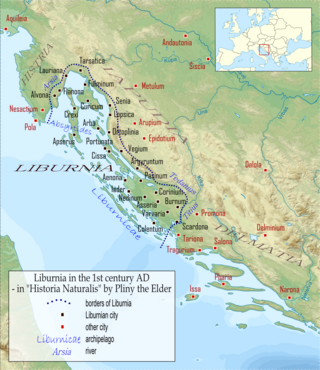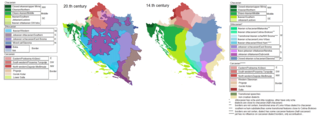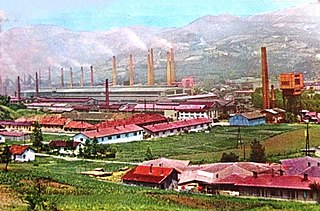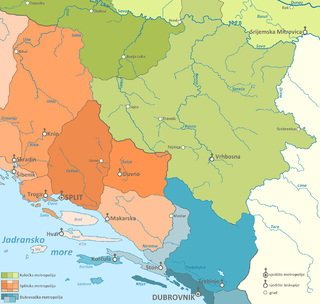History
Roman period
Prior to the Roman conquest, the territory of the present-day Mokronoge was a part of the centre of the Dalmatae, a group of Illyrian tribes.
Mokronoge were part of the Roman municipium of Delminium. Delminium became a municipium during the reign of Emperor Hadrian in the first half of the 2nd century. The municipium was headed by the municipal council, whose members also came from the present-day Mokronoge. In the municipium of Delminium Jupiter was the most worshiped deity, including the present-day village of Mokronoge, which is one of the sites in the area of this municipality where an altar to the god Jupiter was found.
Ottoman period
After the Cretan War (1645–1669) between the Republic of Venice and the Ottoman Empire, the bishop of Makarska Marijan Lišnjić made a visit to the parish of Duvno, of which Mokronoge was a part of, and reported that although the parish of Duvno encompasses numerous villages, none of them has a church. The old churches were destroyed, while the Catholics weren't allowed to build the new ones. On the other hand, the Muslims had a mosque in the town of Županj Potok. The population in the region was small. The Catholics were a minority, but there weren't a lot of Muslims either. The parish priest for the Catholics in the region at the time was their local Ivan Ančić.
In 1743, the apostolic vicar of Bosnia, Bishop Pavao Dragičević ordered a census to be made, which found Mokronoge, at the time part of the parish of Duvno, uninhabited, as the town of Županj Potok itself with other nearby villages. His successor Bishop Marijan Bogdanović conducted a census in 1768, which saw a mild increase in population in the parish of Dunvo. The 19th century was as bad for the Catholics in Bosnia and Herzegovina, as the previous, marked by wars and rebellions. The situation for the Catholics of Duvno was the same. At the time, they had only one parish seated in Bukovica. Mijo Čuić, the local parish priest, decided to move the seat to Seonica in 1806. However, as the parish was geographically too large, he divided it into two and established a chaplaincy in Mokronoge in 1829, which in 1839 became a parish in its own right. However, in 1861, the seat of the newly-established parish was moved to the town of Županj Potok. [9]
Franciscan Petar Bakula wrote two schematisms, one for the Franciscan Province of Herzegovina in 1867, and the other for the Apostolic Vicariate of Herzegovina in 1873. According to these two schematisms, in 1867, Mokronoge had 82 Catholics, and in 1873, their number rose to 110.
Maleševci was a historical Vlach tribe of Herzegovina that existed in the Late Middle Ages.

Tomislavgrad, also known by its former name Duvno, is a town and the seat of the Municipality of Tomislavgrad in Canton 10 of the Federation of Bosnia and Herzegovina, an entity of Bosnia and Herzegovina. It mainly covers an area of the historical and geographical region of Tropolje. As of 2013, it has a population of 33,032 inhabitants.

Prince Tomislav of Yugoslavia was a member of the House of Karađorđević, the second son of King Alexander I and Queen Maria of Yugoslavia. He was a younger brother of King Peter II of Yugoslavia and a former nephew-in-law to Queen Elizabeth II and Prince Philip.

Kupres is a town and municipality located in Canton 10 of the Federation of Bosnia and Herzegovina, an entity of Bosnia and Herzegovina. As of 2013, it has a population of 5,057 inhabitants, while the town of Kupres has a population of 2,883 inhabitants.

Delminium was an Illyrian city and the capital of Dalmatia which was located somewhere near today's Tomislavgrad, Bosnia and Herzegovina, under which name it also was the seat of a Latin bishopric.

Šuica is a village in the Municipality of Tomislavgrad in Canton 10 of the Federation of Bosnia and Herzegovina, an entity of Bosnia and Herzegovina.
Baljci is a village in the Municipality of Tomislavgrad in Canton 10 of the Federation of Bosnia and Herzegovina, an entity of Bosnia and Herzegovina. The village belongs to the local community of Šujica. Until 1945, the village was administratively part of the Srez of Livno.
Ćavarov Stan is a village in the Municipality of Tomislavgrad in Canton 10 of the Federation of Bosnia and Herzegovina, an entity of Bosnia and Herzegovina.
Kazaginac is a village in the Municipality of Tomislavgrad in Canton 10 of the Federation of Bosnia and Herzegovina, an entity of Bosnia and Herzegovina. The village is also part of the smaller Buško Blato micro-region, consisting of those villages and settlements surrounding the lake known as Buško Lake. According to the 2013 census, there were 277 inhabitants.
Oplećani or Oplećane is a village in the Municipality of Tomislavgrad in Canton 10 of the Federation of Bosnia and Herzegovina, an entity of Bosnia and Herzegovina.
Rašćani or Rašćane is a village in the Municipality of Tomislavgrad in Canton 10 of the Federation of Bosnia and Herzegovina, an entity of Bosnia and Herzegovina. According to the 2013 census, it had 41 inhabitants.
Franciscan Province of Herzegovina of the Ascension of the Blessed Virgin Mary is a province of the Catholic religious order of the Order of Friars Minor, commonly known as Franciscans. It was established in 1843 when it seceded from the Franciscan Province of Bosna Srebrena. Its headquarters are in Mostar.

Younger Ikavian, also called Western Ikavian/Western Neoshtokavian Ikavian, or Bosnian–Dalmatian dialect, and Bunjevac dialect, is a subdialect of Shtokavian Serbo-Croatian spoken in Croatia in the Dalmatian Hinterland, in Bosnia and Herzegovina west of the river Bosna and Neretva, and in the Bácska region of Hungary and the autonomous province Vojvodina of Serbia. Most speakers use the Latin alphabet.

Tropolje was a historical Croatian duchy, which was located on the borderland of Croatia, Bosnia and Zachlumia. Its exact borders are disputed among historians.

Bilino Polje, is historic areal and polje, located near town of Zenica, in Bosnia and Hezegovina. Today, Bilino Polje represents an urban area of the town, and it is one of its main local communal self-governing units or Bosnian: Mjesna zajednica.

The Diocese of Duvno was a Latin rite particular church of the Catholic Church that was established in the 14th century with a seat in present-day Tomislavgrad in Bosnia and Herzegovina. It was a suffragan diocese of the Archdiocese of Split, and during the 17th century of the Archdiocese of Dubrovnik. The diocese consisted of four parishes: Roško Polje, Duvno, Posušje and Rama.

Vlachs in medieval Bosnia and Herzegovina were a Western Balkans population descending from a mixture of Romanized pre-Slavic Romance-speaking peoples and the South Slavs. From the 14th century the ethnic meaning of term "Vlach" was replaced with societal meaning and often meant the Slavic population with similar lifestyle. They practiced transhumance as herdsmen, shepherds, farmers, and in time developed peculiar socio-political organizational units known as katuns. With their caravans, Vlach carried out much of the traffic between inland and coastal cities such as Dubrovnik. They also had close contacts and militarily served various Bosnian noble families and kings.
Zdravko Dizdar is a Croatian historian.
Pejo Ćošković, born on 12 April 1952 in Domaljevac near Bosanski Šamac, is Bosnian medievalist and lecturer at the Faculty of Philosophy of the University of Sarajevo, Department of History, in Sarajevo, Bosnia and Herzegovina.

Municipality of Tomislavgrad is a municipality in the Canton 10 of the Federation of Bosnia and Herzegovina, an entity of Bosnia and Herzegovina.











